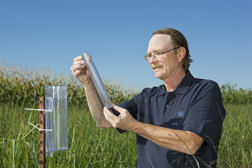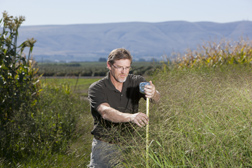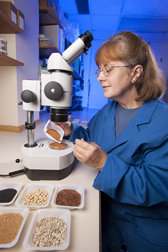Prospecting for Pacific Northwest Biofuel Crops
|
|
Since 2003, Agricultural Research Service microbiologist Hal Collins and agronomist Rick Boydston have been working with colleagues at Washington State University to figure out how an assortment of crops could be introduced into existing high-value irrigated vegetable rotations. Their study—the first of its kind in the state of Washington—included safflower, camelina, soybeans, mustard, canola, wheat, corn, and switchgrass. As a result, there’s now some key information on biofuel crop production for farmers in the region.
“These first trials were initial steps,” says Collins, who works at the ARS Vegetable and Forage Crops Research Laboratory in Prosser, Washington. “We wanted to test a number of bioenergy crops to see if their production in our region was feasible and if they could provide high enough returns to growers by competing with other crops.”
|
|
Cruising on Canola
Canola is a relatively new crop to Washington growers, since few varieties have been specifically developed for environments with cool winters and hot summers. It is not affected by Russian wheat aphid, Hessian fly, or wheat diseases such as take-all, which is caused by the fungus Gaeumannomyces graminis, and eyespot, caused by the fungus Pseudocerospoelle hepitricoides. So when wheat is planted in fields where canola was previously cultivated, the incidence of these pathogens drops.
“We’re finding that canola can be grown in a lot of different environments in the Pacific Northwest,” Collins says. In a study of four different varieties of canola that were cultivated at three sites, the scientists found that the average seed yield was around 3,000 pounds per acre. This would yield around 1,200 pounds of seed oil per acre, which could provide the raw oil to make 160 gallons of biodiesel. A farmer with 1,000 acres and an onsite crusher and biodiesel facility would need 50 to 70 acres to grow enough canola to produce the fuel needed to run on-farm operations.
Winter canola also protects soil from erosion in hilly regions, and the plant’s deep root system, sometimes reaching more than 8 feet below the soil, can break through hard subsurface soil layers. This allows the plant to take up nutrients that have leached below the root zone of previous crops, which helps reduce ground-water contamination. The crop also adds organic matter to the soil—another production plus.
Other Oilseed Options
When a 53-foot, 29,000-pound Air Force A-10 Thunderbolt jet successfully—and uneventfully—completed a test flight using a 50-50 blend of camelina-based fuel and regular jet fuel, producers and scientists alike took note.
“Compared to canola seeds, which are 40 percent oil, camelina seeds are 35 percent oil, and seed yields per acre are lower in our growing conditions,” notes Collins. Still, in field trials, camelina, a shrublike plant with yellow flowers, produced an average of 2,000 pounds of seeds per acre in 80 days. That translates into 700 pounds of oil—and eventually 93 gallons of fuel—per acre.
Safflower plants have bright, bristly blossoms and seeds that contain between 42 percent and 48 percent oil. Their taproot systems can penetrate as deep as 10 feet in the soil to find water, and the plants produce around 3,000 to 3,500 pounds of seeds per acre. The Prosser scientists used deficit-irrigation strategies that resulted in a water savings of 7 inches and only a small reduction in oilseed yield.
White mustard (Sinapis alba), another crop that is fairly new to Washington growers, is also in the mix. The plant performs best with cool winters and hot summers, and its seeds contain about 25 to 30 percent oil. But it is also more drought tolerant than canola—and it could be a very versatile commodity.
“The seeds are crushed for oil, and the mustard meal that remains has high levels of glucosinolate, which acts as a biofumigant,” says Boydston, who also works in the Prosser laboratory. “The meal can be used as an organic fertilizer or as a soil fumigant to suppress harmful nematodes and weeds.”
Field trials indicate that, depending on the variety of oilseed, 50,000 to 80,000 acres would be needed to support a single 5-million-gallon biodiesel facility. And there could be a ready market for that biodiesel, since some estimates suggest that nearly 1 billion gallons of diesel derived from petroleum are consumed every year in Washington. Although there are 10 companies currently producing and distributing biodiesel in the Pacific Northwest, most of it is produced with waste grease.
Switching to Switchgrass
The Prosser scientists aren’t restricting their dealings to oilseed feedstocks for biofuels. Their work suggests that with enough rainfall or irrigation, farmers in the warmer parts of the Pacific Northwest could also grow warm-season grasses, such as switchgrass, for use in cellulosic ethanol production or in gasification plants or other biopower-production facilities.
The team evaluated 11 switchgrass cultivars and found Kanlow to be the most promising cultivar for maximum production under sustainable irrigation strategies in the Pacific Northwest’s Columbia Basin. Four years after the team planted the first crop, they measured yields of 14 dry tons per acre, which could translate into around 1,000 gallons of cellulosic ethanol per acre. New switchgrass cultivars will be added to the trials when they become available.
Of course, the economic viability of any of these potential bioenergy crops depends on further development of the bioenergy industry infrastructure in the Pacific Northwest. The location of future biorefineries will be key to cost-effective biofuel production (see Bionergy Options in the Pacific Northwest article in this issue), as will initial market incentives and support for other aspects of the supply chain.
Collins and Boydston will continue their fieldwork, and they’ll also begin performing the economic analyses. “We’ll evaluate how the crops fit into high-value vegetable production, find improvements in crop irrigation and fertilization practices, and identify uses for biofuel coproducts,” Collins says.
“Biofuels are here to stay in the Pacific Northwest, and farmers are looking for information they can use to produce these crops economically,” adds research leader Ashok Alva. “We need to fine-tune management practices so that the growers will be able to make appropriate decisions on incorporating these feedstocks into their current production systems.”—By Ann Perry, Agricultural Research Service Information Staff.
This research is part of Crop Protection and Quarantine (#304), Agricultural System Competitiveness and Sustainability (#216), and Bioenergy (#213), three ARS national programs described at www.nps.ars.usda.gov.
To reach the scientists mentioned in this article, contact Ann Perry, USDA-ARS Information Staff, 5601 Sunnyside Ave., Beltsville, MD 20705-5129; (301) 504-1628.
"Prospecting for Pacific Northwest Biofuel Crops" was published in the February 2011 issue of Agricultural Research magazine.









